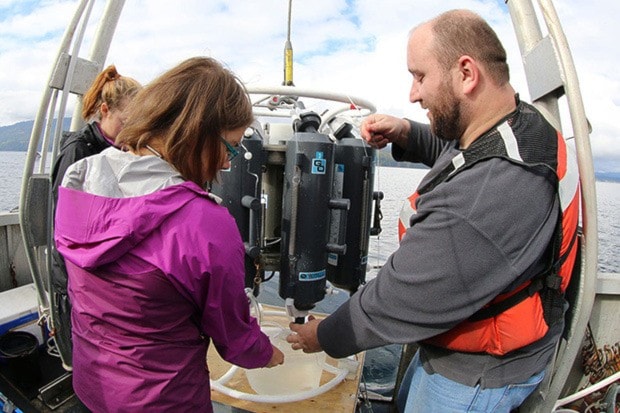Oceanographers from around the world are hoping to learn more about the science of “dead zones,” thanks to a University of Victoria-led research project currently taking place in Saanich Inlet.
Every two weeks since September, a research team on the UVic research vessel MSV John Strickland has been venturing into the inlet to collect water samples at various depths – roughly 300 litres per day – to measure the levels of everything from dissolved gases and trace metals to phytoplankton and microbes.
Saanich Inlet is a deep glacial fjord separated from adjacent waters by a shallow sill that restricts water inflow. It’s widely known as a natural laboratory for studies of “anoxic” or dead zones, areas in the ocean that are devoid of oxygen and marine life. The only lifeforms that can exist there are bacteria.
“The inlet is a natural dead zone, meaning it has low to no oxygen content for most of the year,” says UVic postdoctoral researcher Jeff Sorensen. “We’re seeing dead zones expanding around the world, and that changes what species are able to live there, including a lot of fish and shellfish that people depend on to eat.”
While Saanich Inlet remains anoxic for much of the year, every fall water flows in over the sill and replenishes the oxygen supply. Marine life flourishes for a few months, but wanes again as the water’s oxygen content gets used up.
“We know there’s a cascade of chemical reactions that happen as the oxygen is used up,” says Sorensen. “We want to see how these reactions evolve over time and how they interact with each other.”
Although the inlet’s anoxic conditions have been well-studied in the summer months, little work has been done in the winter. This project, which runs until next May, marks the first time that a wide range of measurements are being taken over the duration of the oxygen depletion process.
About 30 researchers from UVic are involved, as well as scientists from Fisheries and Oceans Canada in Sidney and UVic’s Ocean Networks Canada, which is also providing real-time data in between research cruises from an instrument connected to its first internet-connected subsea observatory, installed in the inlet in 2006. The water samples are being collected close to that instrument.
International scientific interest in the project is broad, with 20 research groups from Switzerland, Ireland, England, Spain, Brazil, the U.S. and elsewhere in Canada signed on for water samples. “These are all world experts in their field who don’t have easy access to a natural dead zone like this,” says Sorensen.
The project is funded by the Natural Sciences and Engineering Research Council.
